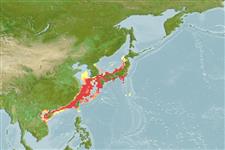Environment: milieu / climate zone / depth range / distribution range
Écologie
marin démersal; profondeur 50 - 100 m (Ref. 11230). Subtropical
Northwest Pacific: southern Japan and Taiwan, throughout the Sea of Japan, the East China Sea, and Taiwan Strait.
Taille / Poids / Âge
Maturity: Lm ? range ? - ? cm
Max length : 31.0 cm SL mâle / non sexé; (Ref. 38037)
Rayons mous dorsaux (Total) : 10; Rayons mous anaux: 8; Vertèbres: 54 - 55. Uniformly brown color; dark distal margins on fins. Fused hypural 3 with the caudal fin terminal centrum.
Found in the sublittoral zone, 50-100 m on sandy mud bottom (Ref. 11230).
Life cycle and mating behavior
Maturities | Reproduction | Spawnings | Egg(s) | Fecundities | Larves
Grande, T., 1999. Revision of the genus Gonorynchus Scopoli, 1777 (Teleostei: Ostariophysi). Copeia 1999(2):453-469. (Ref. 38037)
Statut dans la liste rouge de l'IUCN (Ref. 130435)
Menace pour l'homme
Harmless
Utilisations par l'homme
Outils
Articles particuliers
Télécharger en XML
Sources Internet
Estimates based on models
Preferred temperature (Ref.
123201): 14.5 - 23.4, mean 21.9 °C (based on 37 cells).
Phylogenetic diversity index (Ref.
82804): PD
50 = 0.5625 [Uniqueness, from 0.5 = low to 2.0 = high].
Bayesian length-weight: a=0.00389 (0.00180 - 0.00842), b=3.12 (2.94 - 3.30), in cm total length, based on all LWR estimates for this body shape (Ref.
93245).
Niveau trophique (Ref.
69278): 2.2 ±0.1 se; based on size and trophs of closest relatives
Fishing Vulnerability (Ref.
59153): Low to moderate vulnerability (28 of 100).
